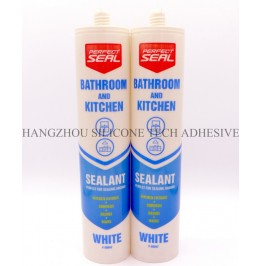Selecting Sealants for Different Water Quality Regions: Key Considerations and Solutions
Sealants are critical for preventing water ingress and structural damage in construction, automotive, and industrial applications. However, the chemical composition of water—including pH levels, mineral content, and impurities—can significantly impact sealant performance. This article explores how water quality influences sealant selection and provides practical solutions for optimizing durability and effectiveness.

Impact of Water Quality on Sealant Performance
Water quality varies widely across regions, with factors such as acidity, alkalinity, chlorine content, and dissolved minerals affecting sealant adhesion, curing, and long-term stability.
Acidic or Alkaline Water Environments
-
Chemical Reactions: Sealants exposed to highly acidic or alkaline water may degrade due to hydrolysis or saponification. For example, silicone-based sealants can weaken in alkaline conditions, while polyurethane sealants may react with acidic substances, leading to brittleness or cracking.
-
Prevention: Opt for sealants formulated with enhanced chemical resistance, such as modified silanes or fluoropolymers, which offer better stability in extreme pH environments.
High Chlorine or Salt Content
-
Corrosion Risk: Chlorine in municipal water supplies or salt in coastal areas can accelerate corrosion of metal substrates beneath sealants, causing delamination.
-
Prevention: Use sealants with anti-corrosive additives or those specifically designed for marine or chlorinated environments. These formulations create a barrier that protects both the sealant and underlying materials.
Hard Water with High Mineral Content
-
Mineral Deposition: Hard water leaves mineral deposits on sealant surfaces, leading to discoloration, reduced elasticity, and compromised adhesion over time.
-
Prevention: Choose sealants with low surface energy or hydrophobic properties to minimize mineral adhesion. Regular cleaning with mild, non-abrasive agents can also help maintain performance.
Selecting Sealants Based on Water Quality
To ensure optimal performance, evaluate the following factors when choosing sealants for different water quality regions.
Chemical Compatibility
-
Material Resistance: Prioritize sealants tested for compatibility with specific water contaminants. For instance, in industrial settings with chemical runoff, select sealants rated for resistance to oils, solvents, or acids.
-
Testing Protocols: Verify that the sealant has undergone accelerated aging tests simulating long-term exposure to target water conditions.
Mechanical Properties
-
Elasticity and Movement Capability: Water pressure fluctuations or thermal expansion in pipelines and joints require sealants with high elongation and recovery rates.
-
Hardness and Abrasion Resistance: In high-flow water systems, harder sealants with abrasion-resistant fillers prevent wear and tear.
Environmental and Health Considerations
-
Low VOC Emissions: In enclosed spaces like indoor pools or water treatment facilities, choose sealants with low volatile organic compound (VOC) content to maintain air quality.
-
Food-Grade Certifications: For applications involving potable water or food processing, ensure sealants meet standards such as NSF/ANSI 61 or FDA compliance.
Application Techniques for Enhanced Performance
Proper installation is as crucial as material selection. Follow these guidelines to maximize sealant effectiveness in varying water quality regions.
Surface Preparation
-
Cleaning: Remove dirt, grease, and old sealant residues using solvents or alkaline cleaners, ensuring a pristine surface for adhesion.
-
Priming: Apply primers compatible with both the substrate and sealant to enhance bonding, especially in porous or contaminated surfaces.
Joint Design Optimization
-
Width-to-Depth Ratio: Maintain a 1:1 ratio to ensure proper sealant compression and prevent water trapping.
-
Smooth Transitions: Avoid sharp edges or irregularities that could create stress points and lead to premature failure.
Curing Conditions
-
Temperature and Humidity Control: Follow manufacturer recommendations for curing temperatures and humidity levels. For example, high-humidity environments may require faster-curing sealants to avoid moisture-related issues.
-
Ventilation: In enclosed spaces, ensure adequate airflow to disperse fumes and accelerate curing.
Long-Term Maintenance Strategies
Regular inspections and upkeep can extend sealant lifespan, even in challenging water quality regions.
Visual and Tactile Checks
-
Discoloration or Cracking: Monitor sealants for signs of degradation, such as yellowing, chalking, or splitting, which indicate chemical breakdown.
-
Adhesion Tests: Periodically check for peeling or lifting at edges, especially in high-stress areas like joints and corners.
Cleaning Protocols
-
Mild Detergents: Use non-abrasive cleaners to remove mineral deposits or biological growth without damaging the sealant surface.
-
Avoid Harsh Chemicals: Steer clear of bleach or acid-based cleaners, which can accelerate sealant deterioration.
Reapplication Timelines
-
Scheduled Replacements: Replace sealants every 5–10 years, depending on exposure levels and performance indicators.
-
Prompt Repairs: Address minor damage immediately to prevent water ingress and further degradation.
By understanding the interplay between water quality and sealant properties, stakeholders can make informed decisions to ensure reliable, long-lasting performance in diverse environmental conditions.
Prev: The temperature adaptation range after the application of bathroom sealant
Next: Prevention of microbial growth after sealant application
